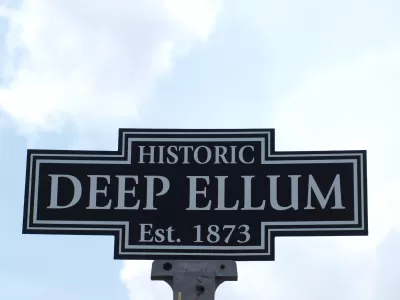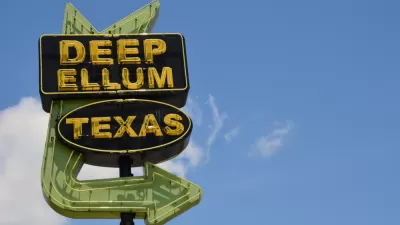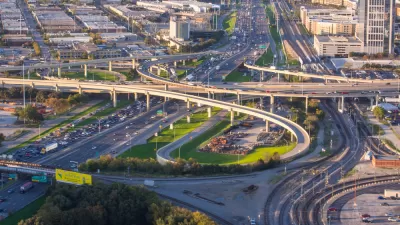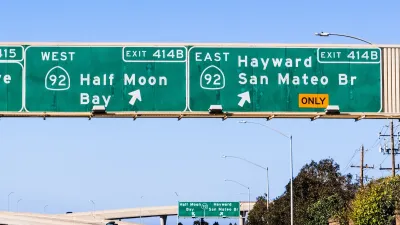A proposal to bury part of Interstate 345 in a 65-foot trench is the latest in a debate that has lasted more than ten years as the freeway reaches the end of its useful life.

The transportation director of the North Central Texas Council of Governments is asking the Dallas City Council to support a plan to bury a segment of Interstate 345 in what Strong Towns recently called an ‘infrastructure grave,’ “which would allow traffic to flow and development to come on decks over the roadway and on surplus right of way.” Critics of the plan say removing the freeway altogether is the best way to begin redressing the damage that the roadway originally caused to surrounding neighborhoods.
As Matt Goodman explains in D Magazine, “The trench would maintain the highway’s present ties to Central Expressway, Woodall Rodgers, and interstates 30 and 45. But it would also create a huge chasm between downtown and Deep Ellum, which makes some on the City Council nervous,” particularly as neither TxDOT nor the city have a plan for funding decking over the trench that could hold future development such as parks or housing. TxDOT insists a proposed plan to replace the freeway with a boulevard would create too much congestion and does not plan to continue studying the boulevard proposal.
The article details the city’s recent growth patterns and the role of I-345 in connecting the southern and northern parts of Dallas, as well as the decade-long debate over how to redesign the aging freeway. According to Goodman, the city council will vote on a resolution to support the trenching project on May 24, which could speed up or delay the project depending on the outcome.
FULL STORY: Transportation Officials Make Public Plea to Support I-345 Trenching Plan

Alabama: Trump Terminates Settlements for Black Communities Harmed By Raw Sewage
Trump deemed the landmark civil rights agreement “illegal DEI and environmental justice policy.”

Study: Maui’s Plan to Convert Vacation Rentals to Long-Term Housing Could Cause Nearly $1 Billion Economic Loss
The plan would reduce visitor accommodation by 25% resulting in 1,900 jobs lost.

Why Should We Subsidize Public Transportation?
Many public transit agencies face financial stress due to rising costs, declining fare revenue, and declining subsidies. Transit advocates must provide a strong business case for increasing public transit funding.

Paris Bike Boom Leads to Steep Drop in Air Pollution
The French city’s air quality has improved dramatically in the past 20 years, coinciding with a growth in cycling.

Why Housing Costs More to Build in California Than in Texas
Hard costs like labor and materials combined with ‘soft’ costs such as permitting make building in the San Francisco Bay Area almost three times as costly as in Texas cities.

San Diego County Sees a Rise in Urban Coyotes
San Diego County experiences a rise in urban coyotes, as sightings become prevalent throughout its urban neighbourhoods and surrounding areas.
Urban Design for Planners 1: Software Tools
This six-course series explores essential urban design concepts using open source software and equips planners with the tools they need to participate fully in the urban design process.
Planning for Universal Design
Learn the tools for implementing Universal Design in planning regulations.
Smith Gee Studio
Alamo Area Metropolitan Planning Organization
City of Santa Clarita
Institute for Housing and Urban Development Studies (IHS)
City of Grandview
Harvard GSD Executive Education
Toledo-Lucas County Plan Commissions
Salt Lake City
NYU Wagner Graduate School of Public Service





























